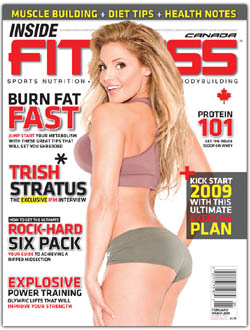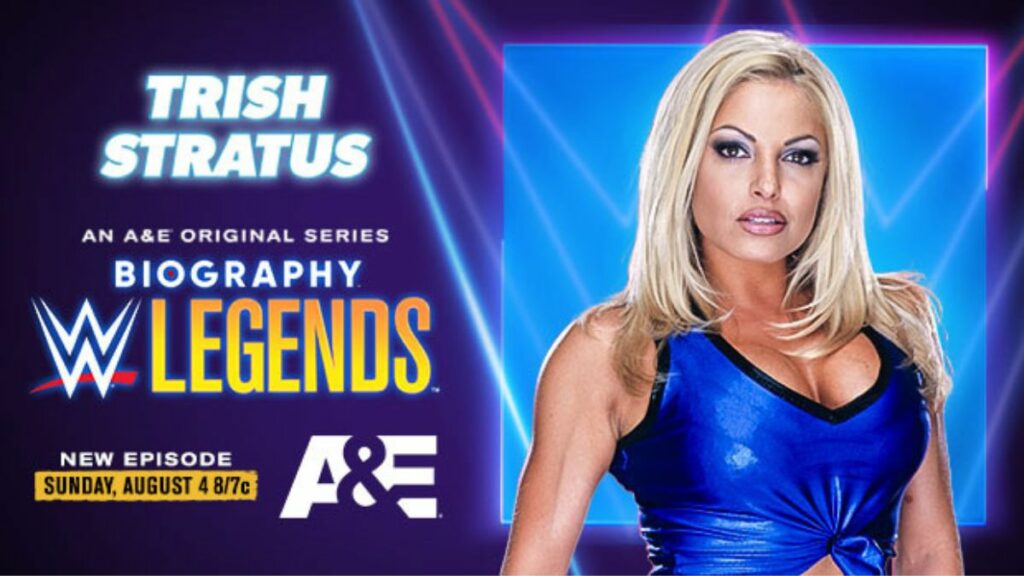There can be too many talking heads in a documentary and it can take away from the subject at hand. Often that happens when the main character isn’t particularly good on screen or maybe unable to truly express themselves.
But Trish Stratus is not either of those, not by a long shot.
So why did we get … let me count … 27 different people talking about her on a one-hour (less commercial time) A&E Biography? That’s not including her kids, who were shown just being with mom. It was a downright blur at times, many popping in just to reinforce something that had just been said.
It’s actually appropriate, though, for a self-admitted workaholic who has always lived life at a “frenetic pace” and in “perpetual motion” with a brain that “never turns off.”
And this was very much about her life, in its totality, with wrestling only making up maybe half of the show (that I didn’t count).
Patricia Stratigeas — though she is never called that and we get no explanation how “Trish Stratus” came about — was a tomboy growing up in Toronto, and ended up marrying one of her childhood pals, Ron Fisico, who was the best friend of her cousin, George James.
Family life is strained, as her father was an alcoholic, so Trish swears off booze. Her mother, Alice, kept the family busy, usually surrounded by the bigger family. The other complication is ulcerative colitis, which Trish experienced regularly as a teen into young adulthood, until it was finally controlled by medication.
At various times described as bookish, nerdy and athletic, Trish has the drive to become a doctor and is in pre-med at York University when the faculty goes on strike (locals like me know this is hardly a one-time deal at York U).
While a bartender at The Docks, a huge nightclub down on the water in Toronto’s east end, she appears on the bar’s billboards, which leads to more modeling work. Throwing herself into it, Trish transforms her body to the point where other fitness models start asking her for advice.
A chance meeting with Michael Hayes in December 1998, who encourages her to send in a package to WWE, gets her thinking more about wrestling — which she had always been a fan of, and had gone to matches at Maple Leaf Gardens.
Trish seeks up Ron Hutchison for training, as she knew that he had taught Edge and Christian. Left out of this is her involvement with The Law radio show in 1999, which led to many more pro wrestling connections. Carl DeMarco, then Canada’s WWF czar, also had a role in pushing her early, but he isn’t mentioned either.
There’s an invite to WWE HQ in Connecticut, and a contract not long after.

For the next bit, it’s mostly things fans know. She is a valet at first to Test and Albert, T&A (get it?), and wants to learn more, and does.
There were so few women at the time, “it felt hopeless at times” said Stratus. Chyna had left the company with the title belt.
Enter Fit Finlay, assigned to revamp the women’s division. He ends up being a great source of knowledge, and a valuable part of this episode.
“I’m training these women every single day to wrestle, not, hopefully, to be doing bra and panty matches. I think having Stephanie there helped our cause. It certainly boosted it. … all the women knew that Steph was behind them and if Stephanie McMahon is in this, we’re good,” Finlay said. “With Trish, it was mind-blowing how quickly she picked it up. She was tough. I’ve seen her cut her eye open, get stitched up and then work the next day. … She was determined to get to the top and she accomplished it.”
Now add about a dozen more people saying the same thing (Brian Gewirtz, the Dudleys, Edge, Mickie James, Terri Runnels, Molly Holly, to name a few) and you can sum up a big part of the story. Lilian Garcia was probably the most interesting to hear from, since we don’t hear from her often and their relationship was different than, say, Trish’s constant opponent and BFF, Lita.
Surprisingly, they dwelt on the terrible bout Trish had with the debuting Tough Enough winner Jackie Gayda, an example of how her inexperience was exposed having to work with a rookie rather than more experienced women.
Unsurprisingly, all the truly terrible, sexist things she was forced to do on the show, like barking like a dog for Mr. McMahon, were put to the side, but it would have been interesting to have heard her take on those memorable, cringe-worthy moments.
Unsurprisingly, the December 6, 2004, main event on Raw, against Lita, gets a good chunk of time.
Trish Stratus and Lita at the Legends of the Ring fan fest on Saturday, June 11, 2022, at the Apa Hotel, Iselin, NJ. Photo by George Tahinos, https://georgetahinos.smugmug.com
Title wins, learning to do promos, studying to get better. We got to see her notebooks from the road, and we learn that she got tapes of Raw and Smackdown sent to her to watch at home. “Wow, obsess much?” she cracked at one point.
Her honesty about life on the road was refreshing, and the male subjects rarely are so revealing about the actual physical challenges. Trish remembered driving and being in tears after matches; “It’s so hard to just keep it going. Your body is in pain. You’re doing everything you can, you’re contributing all the way you can, and it was never enough.”
At age 30, wanting to have a baby, she turns down a five-year renewal and goes out a champion. Unknown to fans was that her own mom was diagnosed with Hodgkin’s lymphoma around that time. “The decision was clear to me,” Stratus said, about leaving the road.
There were times when her colitis was an issue on the road, but she always kept going. Her future husband (they married after she quit WWE) may have kept her “grounded”, meaning she could drop the persona at home, but he was also the one carrying her up the stairs.
Lita saw all that, and offered up soundbites, like how Trish was “driven by work,” had to “be reminded to slow down” but was always “all smiles” through all the colitis issues. “If given the opportunity, she will run herself ragged,” Lita summed up.
Ron Hutchison and Trish Stratus at the 2016 Cauliflower Alley Club reunion. Photo by Brad McFarlin
Yet when Trish stopped wrestling, she didn’t stop anything. There were TV shows and movies, the yoga studio, and much more.
In a flash it was almost a decade later, and they were having fertility issues. Trish was wracked with guilt, thinking that selfishly she had ruined her chances of starting a family. But her and Ron persevered, and their son and daughter are proof.
With grandchildren, her father came back into her life. This was the point where Trish got the most emotional, recalling how she had thought he hadn’t paid attention to her career, but after his death, she found everything he kept about her.
It was refreshing — but not unique to celebrity — to hear someone talk about “mom guilt” and finding that balance between family and having your own identity.
Of course, not just anyone can get back into the ring after 13 years and face Charlotte Flair at SummerSlam in 2019. “I never thought I would get back in the ring,” she said.
Rinse, repeat, even if more recent Trish Stratus appearances in WWE are left out.
We’re not done with Stratusfaction, and I’m okay with that.
When this documentary gets updated in another 10 years, let’s cut down on the talking heads, though, eh?
RELATED LINKS
- Trish Stratus story archive
- Slam Wrestling’s WWE on A&E archive
